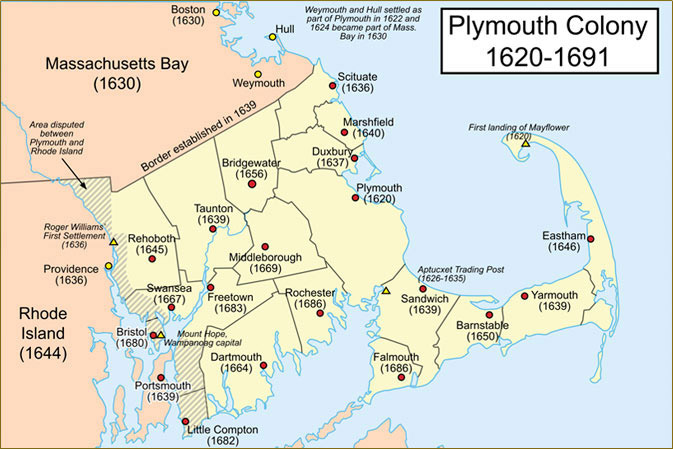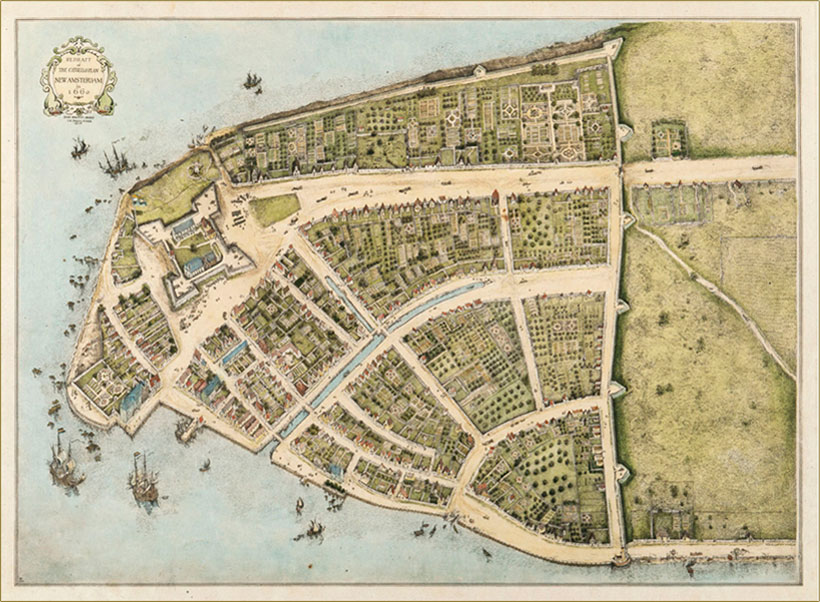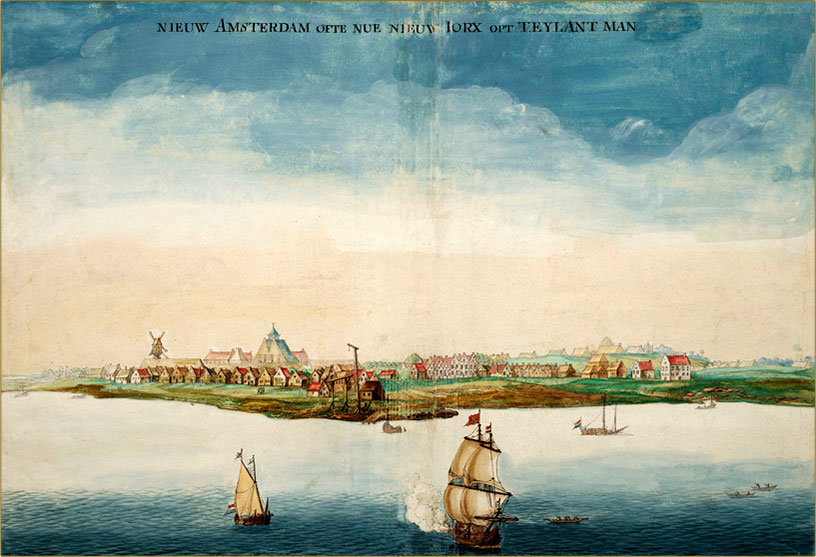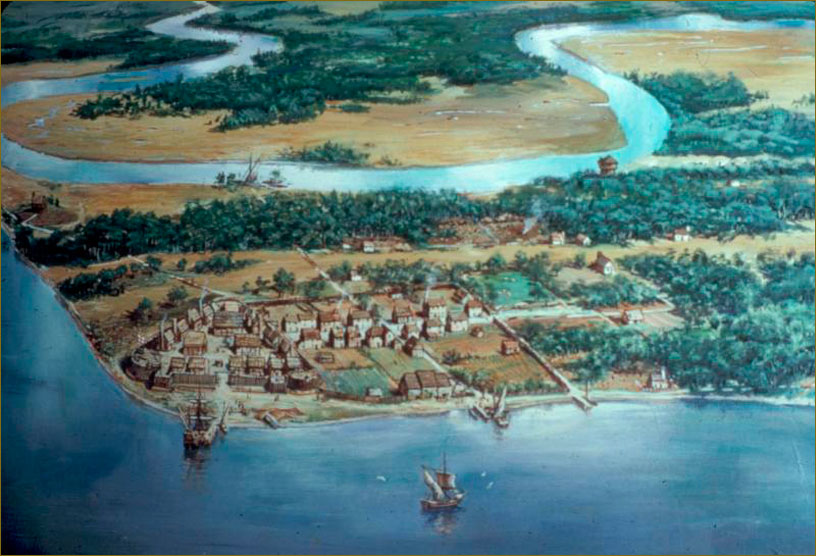Click each label on the map to learn about the four settlements.
Map of the Eastern United States with Four Settlements Labeled.
Plymouth New Amsterdam Jamestown RoanokePlymouth
Close Popup
British Puritans, in search of religious freedom, founded the settlement of Plymouth in 1620. Plymouth is located on the Atlantic coast of what is now Massachusetts. The Puritans set sail with 102 passengers and the ship's hold full of water, sugar, oatmeal, meat and cheese, as well as furniture and tools. The Puritans had intended to settle near what is now New York City, but weak winds forced them to land their ship, the Mayflower, near Cape Cod in Massachusetts. A group of men explored the area for several weeks before selecting an abandoned Wampanoag village as the place for their settlement. They saw that the site, located on a hill, had plenty of fresh water, a nearby harbor for ships, and areas already cleared of trees that had been used as fields by the Native Americans.

Image credit: Prints and Photographs Division, Library of Congress.
The colonists arrived at their new home at the very beginning of winter. As they began to build houses, many colonists, weakened by the cold and wet weather, fell ill. They were also weakened by the limited variety of food from their ship, and they were unable to grow new food until the spring. Over half of the colonists died that first winter from the harsh winter and illness.
The next spring, the Wampanoag helped the colonists to plant their crops and introduced them to new crops such as Indian corn. Colonists grew food, and they fished and hunted. They began to trade their extra food with the Native Americans for furs, which they sent to England in return for English goods. Over the next six years the colony thrived as babies were born, crops grew well, and more settlers arrived from Europe. By 1627, there were about 160 people in Plymouth.
New Amsterdam
Close Popup
Image Source: New-York Historical Society Library, Maps Collection
In 1624, 30 Dutch families arrived in the New World and established several settlements, including one at the tip of the island of Manhattan. They chose this spot due to its location at the mouth of the Hudson River, which allowed the settlers access to the fur trade with Native Americans up and down the river.
The colony had a good climate with warm summers and cold winters. Families began to engage in the fur and fish trades, sending their goods to markets in Europe. As the settlement expanded, colonists began to establish farms as well, and grew grains and other crops for the traders in the settlement.

Image Source: Geheugen van Nederland (Memory of The Netherlands), Selections from the Map Collections
Although some colonists decided to return to the Netherlands, by 1630, the colony had about 270 people. The settlement faced challenges as it tried to expand into the English-controlled Connecticut River. In addition, the colonists pushed the local Native Americans off their land, which created conflicts between Native Americans and the colonists. However, the colony continued to grow, expanding up the Hudson River and along the coast of New Jersey. The colony became wealthier from the fur trade. By 1655, there were over 2,000 colonists living in the settlement of New Amsterdam and the colony of New Netherlands.
Jamestown
Close Popup
Image credit: National Park Service, Colonial National Historical Park, Jamestown Collection
British settlers founded the settlement of Jamestown in 1607. The settlement was backed by British investors who hoped that the success of the settlement would make them rich. Three ships, carrying 105 colonists, set sail from England. They chose a site on the James River near the mouth of the Chesapeake Bay because it had a good harbor and would be easy to defend against enemies.
The settlement struggled in its early years. Because the river and the settlement were near the Chesapeake Bay, there was little access to fresh water, and settlers became sick after drinking the brackish river water. Warfare broke out between the colonists and the local Native American tribe, the Powhatans. At least 80 percent of the colonists died during this time. By 1610, the colonists were ready to abandon the settlement. However, a new ship arrived with new settlers and supplies, and this revitalized the colony.
The Jamestown settlers tried many different activities to make their settlement profitable. They tried making glass, cutting timber, and producing tar. However, in 1613, a colonist introduced tobacco, and the settlers began to grow and sell their tobacco to England. New settlers poured into the colony to provide labor to grow this new valuable crop.
Roanoke
Close Popup
Image Source: The British Museum
In 1585, English soldiers visited the island of Roanoke and unsuccessfully tried to establish a colony. The soldiers returned to England; and although unsuccessful in establishing a colony, they did have glowing reports about the richness of the land and its warm and favorable climate.
In 1587, a new group of 117 English colonists arrived to re-establish the colony of Roanoke. The new colonists soon began to have trouble with the local Native Americans, who were already upset that the earlier English colony had taken good land. The governor of the settlement, John White, left to return to England for supplies. Unfortunately, he was delayed by England's war with Spain, and it was three years before he could return. When John White finally arrived back in Roanoke in 1590, he found the colony deserted. No one knows what happened to the settlers at Roanoke. They may have died from starvation or disease. They may have been attacked by Native Americans. Or, they may have become frustrated with waiting for White to return and decided to move inland to join forces with friendly Native Americans.
Because this colony's end is a mystery, it is known at the "Lost Colony of Roanoke." We do not know a great deal about the colony, such as what challenges the people faced or how they tried to make a living.